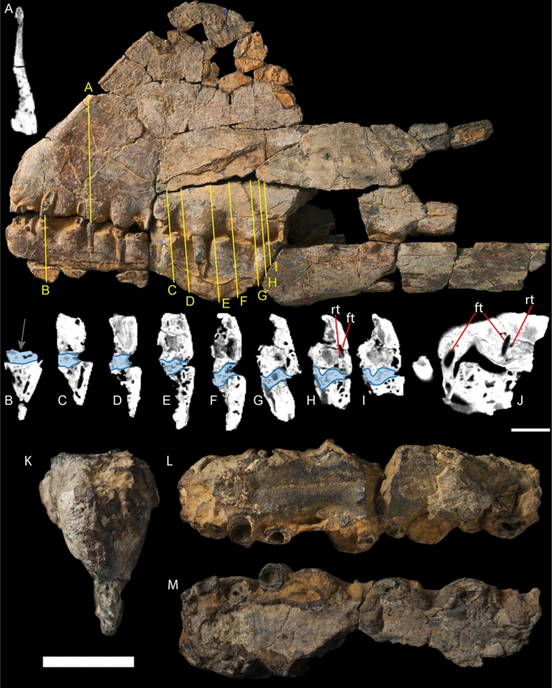
Ferrodraco lentoni gen. et sp. nov. holotype. Scale bar = 50 mm. From Pentland et al., Scientific Reports.
Pterosaurs were the first flying vertebrates. From the Late Triassic to the end of the Cretaceous, the evolution of pterosaurs resulted in a variety of eco-morphological adaptations, as evidenced by differences in skull shape, dentition, neck length, tail length and wing span. Their reign extended to every continent, but due to the fragile nature of their skeletons the fossil record of pterosaurs is rather patchy, with most occurrences limited to fragmentary remains. The newly described Ferrodraco lentoni, from the Winton Formation (Cenomanian–lower Turonian), is the most complete pterosaur specimen ever found in Australia. Previously, and only based on fossil skull fragments, two other species of pterosaurs were described from Australia: Mythunga camara and Aussiedraco molnari.
Discovered in 2017, the holotype specimen AODF 876 (Australian Age of Dinosaurs Fossil) includes a partial skull, five partial neck vertebrae, and bones from both the left and right wings. The wingspan of Ferrodraco was approximately 4 m, with a skull probably reaching 60 cm in length. The generic name comes from the Latin language: ferrum (iron), in reference to the ironstone preservation of the holotype specimen, and draco (dragon). The species name, lentoni, honours former Winton Shire mayor Graham Thomas ‘Butch’ Lenton.

Ferrodraco lentoni gen. et sp. nov. holotype rostral sections AODF 876. Cross-section. Scale bar = 20 mm. From Pentland et al., Scientific Reports.
Based on several cranial synapomorphies, including the presence of a mandibular groove, smooth and blade-like premaxillary and mandibular crests, and spike-shaped teeth, Ferrodraco falls within the clade Anhangueria. This group has also been recorded in the Early Cretaceous of Brazil, China and England. It has been suggested that anhanguerians went extinct at the end of the Cenomanian. This interval was characterised by an increase in atmospheric and oceanic surface temperatures, a global oceanic anoxic event, and marine transgression. Given that Ferrodraco was recovered from a locality northeast of Winton, which is considered as early Turonian in age, the new specimen potentially represents a late-surviving member of the anhanguerians.
References:
Adele H. Pentland et al., Ferrodraco lentoni gen. et sp. nov., a new ornithocheirid pterosaur from the Winton formation (cenomanian-lower turonian) of Queensland, Australia, DOI: 10.1038/s41598-019-49789-4